Part Two

The Sword of God
In the Schatzkammer section of the Art Museum of Vienna, among many swords on display, there is one that is thought to be Attila's. Actually it is a saber. If one were to make a careful and close examination of the workmanship and the decorative motifs found upon it, there is no doubt that one would arrive at the following conclusion: that saber bears the typical and unmistakable work of a Hungarian goldsmith from the IX-X century. On the handle there are three rings decorated with precious stones; obviously, this saber wasn’t made for use in battle, or for everyday use of any kind. The gold-plated handle shows no wear or tear whatsoever; however, someone may have worn it on special occasions or used it at sacred ceremonies. The mother of King Salamon (1063-1074) gave it to Prince Otto Nordheim, which indicates that this saber was in the possession of the Hungarian kings who inherited it from earlier rulers.
Horsemen of the plains dominated the vast area from the Carpathians to the Altai Mountains and beyond for millennia. Their culture and civilization were different from those of the western peoples, and throughout the centuries they fought many wars. Because of their sheltered life, the people of the West had become somewhat soft, while the people of the plains remained rough and at one with nature. They were the greatest warriors the world had ever known. Bravery was instilled in them from childhood onward; bravery was implanted into the depths of their soul. They lived by the sword and they died by the sword. It is no wonder that to them the sword (saber) was a sacred object, which they revered. They were empowered by it.
The Sword of God had a magic power; it was either inherited or specially made for great rulers such as Attila or Álmos. According to some sources, the Scythians used iron from a meteor to make the Sword of God, most special indeed. After the blacksmith fashioned the sword, it was placed on the top of a mound, standing it up like a lightning rod, waiting for the lightning to strike it. If this happened, it was believed to be the will of God, and this gave the sword a magical power. This power from the sword was transferred to its owner and was given to him by God, so he ruled by the will of God.
The saber of Vienna is most likely one of the Swords of God, probably the only one in the Western World that has never been buried in the ground.
The Reflex Bow
Hunters and warriors have used the bow for thousands of years. One of the most effective, the most feared, and deadliest of all was the reflex bow that was developed by the horsemen of Central-Asia in the first millennium B.C. The Scythians, the Huns, the Avars and the Magyars, just to mention a few, were masters in the making and handling of this weapon. Compared to other bows, the reflex bow was smaller, more powerful and more practical in hunting or shooting from horseback. An arrow shot from it could travel about half a mile's distance, was capable of piercing some light body armor, and was lethal at about 300-400 yards. (Western bows had only about half the range.) The warriors of the East were masters in handling these bows and they shot their arrows with great accuracy from their galloping horses. Even in a retreat (real or tactical), the stirrup enabled them to turn facing backwards on their horses, allowing for the very effective use of these weapons. A skilled horseman in Hungary can demonstrate very convincingly that this can even be done without the stirrup.
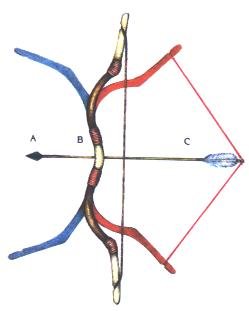
Reflex Bow: Blue is the position of storage; brown is ready to use; red is ready to shoot.
Reflex bows were made of wood, horn, sinew, and some fish-glue; due to the type of glue used in their manufacture, this weapon could only be employed in dry weather. It took a great deal of skill and a number of years to make just one. In order to use these weapons effectively, one was trained from childhood to develop the necessary skill and muscle.
The Hungarian DogsThe most famous and internationally known Hungarian dogs are the Komondor, Kuvasz, Puli, and the Vizsla. The Vizsla is a hunting dog with about five hundred years of documented history and is well known to American hunters. The other three are excellent, if not the best guard dogs there are. Their origin has not been satisfactorily determined; however, the names of these dogs have been found on Sumerian clay tablets: Ku-Assa for Kuvasz, Kumundur for Komondor and Puli for Puli. Furthermore, the Sumerian word for dog is kudda; in Hungarian it is kutya - suggesting that these three dogs may have come with the ancient settlers out of Anatolia into the Carpathian Basin. They are probably the oldest domesticated dogs going back to about eight thousand years. These dogs are easily trained; most discipline comes naturally to them.
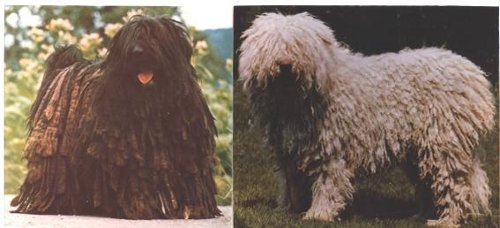
The Puli and the Komondor
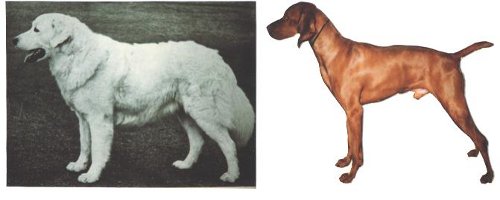
The Kuvasz and the Vizsla
The Conquest of King Árpád
In 1996, Hungarians throughout the world celebrated the anniversary of the establishment of their homeland in the Carpathian Basin in A.D. 896. However, this date is incorrect due to the fact that this conquest took place in 895 A.D. (The celebration of the millennium was postponed a year due to the fact that Budapest's first subway was under construction. It was completed in 1896.) It has been extensively debated in the past one hundred fifty years, not only just what exactly took place before, during, and after the conquest, but just who Árpád's people really were: what their origin was, what language they spoke, whom they found in the Carpathian Basin, and how many tribes or nations took part in this bold undertaking and so forth. The following may shed some light on some of these questions.
It seems that the year 895 or 896 is arbitrary because the conquest of the Carpathian Basin was not an exclusive and singular military undertaking. It was more likely a process perhaps beginning in 892, but no later than 895 extending their rule over western Hungary (Pannonia, today's Dunántúl) in the year 899 that marks the end of their conquest; thus, the year 895 seems realistic. In 894, Emperor Leo of Byzantine established an alliance with King Árpád (or perhaps his father Álmos, who had already been in alliance with Arnulf the Frankish emperor since 892) against the Bulgarians. Byzantine ships carried some of Árpád's troops on the lower Danube to the battlefield. The decisive battle was fought outside of the southern Carpathian Mountains, along the Danube River, with heavy losses on both sides. It is not known whether Emperor Leo was aware of Árpád's real intentions or not, but he made peace with the Bulgarians while the fighting went on. After the Bulgarians were defeated, Árpád's people began to move into the Carpathian Basin, settling their families and livestock in the area.
Unfortunately, the origin of Árpád's people has never been satisfactorily resolved. Therefore, here is what is considered the most likely scenario: The Khazar writings contain some mention of Árpád's people; the implication is that around 820 A.D, Ügek (Árpád's grandfather) and his people were under their rule. This is probably true to a certain extent because some of the nations/tribes, but not all of them, were under Khazar rule. Indications are that the federation was composed of two major ethnic groups of people; each may have spoken a different tongue. The Sabir nations Megyer, Tarján, Jenő and the partial Gyarmat were believed to have spoken Hungarian. The two Onugor nations, Kér and Keszi, and the partial Kök-Türk Kürt nation spoke Turkish, and most likely did the Nyék nation too, which had close ties with the Sabir nations (these nations in the second group may have been under Khazar rule). It is not clear whether Álmos or Árpád married the daughter of the leader of the Nyék nation, but it slowly pulled away from the Khazar Empire sometime after the marriage. If the Onugor nations were under Khazar rule, they had no doubt pulled away by the time of the Vérszerződés which took place between the years 888-891 A.D. the taking of this oath indicated that they were getting ready for the conquest of the Carpathian Basin.
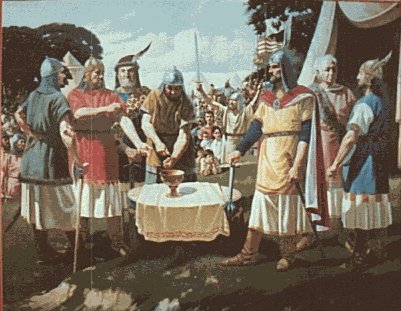
Vérszerződés: The Covenant of Blood by Lajos Káy
The Vérszerződés was an oath; two or more parties swear an oath in blood to each other, for instance, that their friendship will never be broken or perhaps to formalize the merging of two or more tribes into one nation. In the case of Árpád's people, the leaders of eight nations consisting of perhaps two major languages or ethnic groups took the oath. This alliance was formed with the intention of conquering the Carpathian Basin. Taking place at a time when Árpád's father, Álmos, was still ruler, a massive undertaking was planned in advance. They agreed to the following:
-
As long as they and their descendants were alive, they would elect a leader from the descendants of Álmos.
-
They would all share equally in the land and goods they acquired.
-
The leaders, having elected Álmos to be their king, made the decision of their own free will. Furthermore, neither they themselves nor their descendants should ever be excluded from the central ruling council and other leadership positions in the country.
-
If anyone among their descendants were to become unfaithful to the king, or conspire against him and his relatives, the blood of the guilty should flow like theirs did in the oath they took to king Álmos.
-
If anyone among King Álmos' and the other leaders' descendants were to violate the agreements which they sealed with their oath, they should be cursed forever.
It seems like this agreement was done in the name of Democracy.
Herodotus, the Greek historian in the fifth century B.C. was probably the eyewitness to an oath-taking much like the Vérszerződés, for he describes one such event in great detail in his work on the Scythians. He wrote the following: "...a large earthen bowl is filled with wine, and the parties to the oath, wounding themselves slightly with a knife or an awl, drop some of their blood into the wine; then they plunge into the mixture a scimitar, some arrows, a battle-axe, and a javelin, all the while repeating prayers; lastly, the two contracting parties drink each a drought from the bowl, as do also the chief men among their followers."
The oldest Hungarian flag from the XI century displays four red and four white stripes, suggesting the original eight fejedelem, horka (head of the nations) had made an alliance with one another. These nations are represented by the eight stripes on the right side (left side facing it) of the Hungarian Coat of Arms. Some researchers believe that the number of nations that took part in the conquest may have been as high as ten. If so, they must have joined after the oath-taking ceremony, because they did not enjoy the same rights and privileges, as did the original eight.
The Sabir nations lived next to the Khazar Empire, just north of the Azov Sea. The first mention of them was in 839, when their troops appeared in the lower Danube region. This was around the time of Árpád's birth. Within a couple of decades, in 862, the young prince would lead the first military venture into Pannonia. From this point onward, Árpád's people were a factor and force in European politics and history.
According to some historians, the advancing Patzinaks forced Árpád’s people out of their homeland, north of the Black Sea. This has never been substantiated, and the string of successful military ventures beginning in the year 899 convincingly refutes this theory.
Once they established firm control over the newly acquired territory, Árpád's people held the first national convention and divided the land between themselves, according to their contract agreed upon in the Vérszerződés. The Onugor tribes chose to settle on the borders of the newly conquered homeland and were in close contact with their new neighbors. These neighbors called the newcomers Ungar or Hungar, relating them to the Huns. This is how the root of the internationally used name, ‘Hungarian’, first came into being. Hungarians in their own tongue call themselves Magyar.
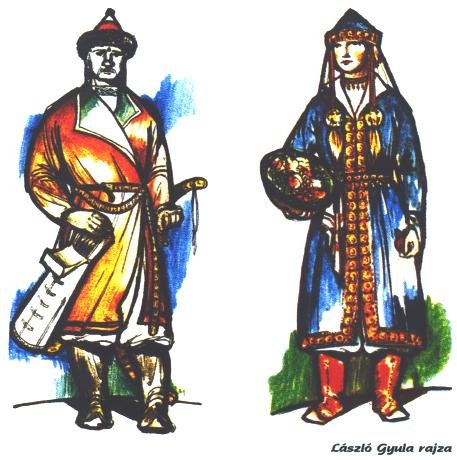
X. Century clothing of men and women
Still being debated is the size of the total population of the new alliance. In the past, it was believed to have been between 200,000 and 500,000 people; however, some put the figure much higher than this. Based on recent research, their numbers most likely did not reach two hundred thousand. The reevaluation is entirely reasonable. As Hungarian archaeologists excavated more and more cemeteries from the 9-11th centuries, they began to recognize that the numbers of the indigenous common people (the farmers erroneously thought to be Slavs) were far greater than they ever imagined, while they found les than a 1000 graves that could be positively identified as one of the conquerors. A scholar in 1959 came to the realization that, if these common people were Slavic speakers, the tongue of Árpád would have dissolved into their language and the people of Hungary would not be speaking Hungarian today. The problem was, and still is, that the artifacts of these common people cannot be traced back to southern Ukraine where Árpád's people had come from.
Professor Gyula László, a noted archaeologist, has shaped an innovative theory: the possibility that perhaps the second wave of Avars (who had moved into the Carpathian Basin around 670) were, in fact, the first Hungarian speaking people. Here again, the problem was that the artifacts of the Avars and the indigenous people in question were dissimilar; they were not of the same stock biologically or culturally and these indigenous people vastly outnumbered the combined population of the Avars and Árpád's people. Furthermore, according to Chinese sources, the early Avars spoke mainly the Turkish language, although they may also have had some Mongolian speaking tribes. Some scholars believe that Árpád's people also spoke Turkish. No doubt this has some merit to it as we see it. The question is then: who spoke Hungarian? The three and a half nations of the Sabír people could not have been the language giver to all of the people of the Carpathian Basin, even if they had spoken Hungarian. The presence of the indigenous common people, the ancient settlers with their overwhelming numbers, suggests that they were speaking the Hungarian language. The language, or the languages of the Avars and Árpád's people, made their mark on the Hungarian language, but they could not ultimately change it.
Based on archaeological evidence, it can be stated that in the 10th century A. D. there were three major groups of people in the Carpathian Basin: Árpád's people, the Avars, and the common people or ancient settlers. Modern Hungarians are, therefore, the fusion of these three major groups of people.
The culture, the clothing, the structure of society, and the battle tactics of Árpád's people were typically Hun in appearance, similar to the Turkish at the time of the conquest. They were great warriors and magnificent organizers. They have laid the foundation for a powerful nation, which for six hundred years played a major role in European politics and history. Whether they spoke Hungarian or not, whether the name Magyar could be attributed to them or not, their accomplishment stands tall like a flag on the battlefield and their memory is written in gold in Hungarian history. In 1996, all Hungarians bowed their heads in respect and pride to the people of King Árpád! The time has come for the revision of Hungarian history, especially in regard to the origin and the language of the Hungarians.
One of their favorite battle tactics was the deceptive retreat, while they were firing their arrows. With this maneuver, they were able to disrupt the enemy’s formation.
In 955 A.D., the German Emperor's (Otto the Great.) son and son-in-law Conrad the Red revolted against the Emperor, inviting the Hungarians to help. The Hungarians accepted the invitation. By the time they reached Augsburg (Germany), unknown to the Hungarians, Ludolf and Conrad had made peace with Otto. The combined German forces turned against the Hungarian forces and gained the upper hand. After the Hungarians agreed to lay down their arms, they were massacred, some being buried alive. The leader of the Hungarian campaign was Bulcsú, one of the greatest leaders and military tacticians of the X century. The loss was staggering: Bulcsú lost his life and his defeat in Augsburg marked the shift in Hungarian foreign policy toward the West. From this point onward, western military ventures ended; they continued eastward towards Byzantine up until 970’s. Contrary to the belief still held by many, looting and pillaging were not the major objectives of these Hungarian military campaigns. They were politically motivated. Fully 94% of them were carried out in alliance with some inviting party. For example; when the people of Tuscany revolted against of Pope John X., he called on the Hungarians for help.
In 972, Géza became the Hungarian nagyfejedelem (archduke). He made peace with the German Emperor Otto the Great at Quedlingburg. At this time, there was a conflict between Otto and the pope, and Géza of Hungary played the role of the impartial broker. As a result, Géza became the supporter of the politically charged Roman Catholic Church and set forth a western oriented foreign policy. He sent for western priests to enter Hungary; they were the educators of his children. In order to establish a firm western alliance, Géza's son István (Saint Stephen) married Gizella in 995, the sister of the Bavarian prince Henrich, who later became the German emperor as Henrich II. A similar peace treaty was made with Byzantine and with the Bulgarians in 978 A.D.
Géza died in 997, and István inherited the Hungarian throne. He continued his father's westward-leaning policy. István brought German Knights into the country, appropriating a great deal of lands, riches, and special privileges to them. His policies intimidated the old power structure and excluded it from seeking leadership roles, in violation of the Vérszerződés, led to his heavy reliance on these Knights for protection. And on the top of this, when Pope Sylvester II ordered the confiscation and destruction of the objects written in the traditional Hungarian runic writings and forbidding its use any further, the leaders of the old guard took exception to that. It was an attack on the Hungarian culture; it was the beginning of the conflict between the old and new. Koppány of Dunántúl in 999, Gyula of Transylvania in 1002, and Ajtony of southern Hungary in 1003, took up arms not to defend the old way of life, but to defend the culture. István put down these revolts with the help of the foreign Knights. These revolts have been characterized as "anti-Christian", which is total nonsense. On the contrary, by this time the Hungarian nobility was Christian and they were very tolerant of religious differences.
The Hungarian Runic Writing
Early forms of writing began with numerical and seasonal notations; pictographs followed. In Mesopotamia, these symbols evolved into cuneiform writing. In Egypt they developed into the high art of hieroglyphics. Some believes the runic writing is derived from these two ancient forms of writing. A Hungarian researcher, Csaba Varga believes that the runic writing actually goes back some 30,000 years and developed on its own. After all, it is highly improbable that simpler forms of writing such as this would evolve into the more intricate cuneiforms or hieroglyphics. So, a reexamination or perhaps the revision of present day knowledge, especially regarding the origin of said writing, should be in order.
|
Latin |
Hungarian |
Hieroglyphics |
Runic |
English |
|
A |
s-A-s |
|
|
Eagle |
|
F |
FE-száll |
|
|
Fly |
|
H |
HÁ-ló |
|
|
Net |
|
L |
LÉ-p |
|
|
Step |
|
M |
MA-rok |
|
|
Grasp, Grip |
|
|
|
|
|
|
|
M |
MA-dár |
|
|
Bird |
|
T |
TE-nyér |
|
|
Palm (of hand) |
(See Editor's note)
Many people used runes, among them Hungarians. Some historians believe that the Hungarian runes are of Khazar-Turkish origin. Comparative studies, however, suggest otherwise. The Hungarian runic characters show a 28.6% resemblance to the Turkish, while showing a 43.4% resemblance to the Etruscan and 50.0% to the Phoenician. Many Hungarian runic letters show close resemblance to some of the Egyptian hieroglyphics also.
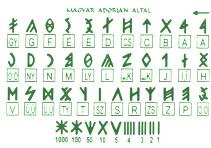
Hungarian runic alphabet
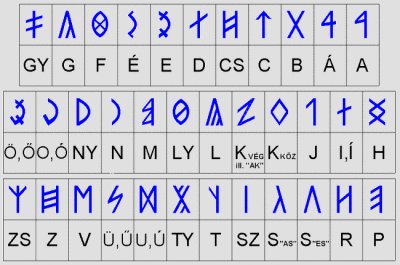
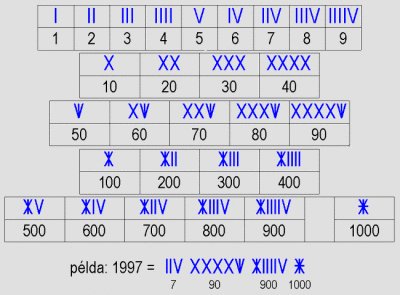
(See Editor's note)
There are 34 letters in the Hungarian runes, one for each basic sound in the Hungarian language. In order to shorten the writing, these letters have been used in the manner of ligature (combining of multiple letters). Some two hundred years ago the runes were still in use in Transylvania.
In 1999 a piece of a clay blowpipe used for pumping air into an iron smelting foundry was found in Bodrog (Western Hungary) with runic inscriptions on it. The characters are typically Hungarian, and only the first letter has two possible interpretations. Everyone agrees that it is written in Hungarian, and it is about eleven hundred years old.
The numbers of runic writings that remain from the early Christian era are few and far between. The reason for this is twofold. For one, they used wood to ró (write) on, and as we know wood is highly perishable. The second is that in the year 999 or 1000 Pope Sylvester II ordered the "pagan" writing of the Hungarians to be destroyed. (The Viking runic writing suffered the same fate.) This provoked a revolt against the Roman Catholic Church, which is characterized as an anti-Christian "pagan" uprising. It would be far more accurate to say that the two cultures – the Christian and the Hungarian – collided head-on. The nobility at this time was Christian; presumably they would not lead a revolt against the Church for religious reasons.
The Holy Crown of Hungary
Like most objects from the ancient past – treasures or archaeological – the Hungarian Holy Crown is surrounded by intriguing mysteries; this is true in respect to its material history and its idealized concept of governing. First, however, let's recap the official version of this Crown's unique history.
According to the official version, the top cross section of the Holy Crown was given to István (Stephen, declared "Saint" in 1083), the first Christian king of Hungary in the year 1000 A.D. by Pope Sylvester II. The bottom band (hoop, rim) of the Crown was a present from the Byzantine Emperor, Michael Ducas to another Hungarian king, Géza I who ruled Hungary between 1074-1077. Eventually someone combined the two sections into one single crown.
Fleeing from the advancing Soviet Armies near the end of World War II, the guards of the Crown (in order to protect it) brought it to Austria and buried it. At the end of the hostilities, they turned the Crown over to the American occupation forces; in 1978 the Holy Crown was returned to Hungary. In the early 1980s, some engineers and goldsmiths were given permission to make a close examination of the Crown and these examinations brought about many new discoveries and surprising results.
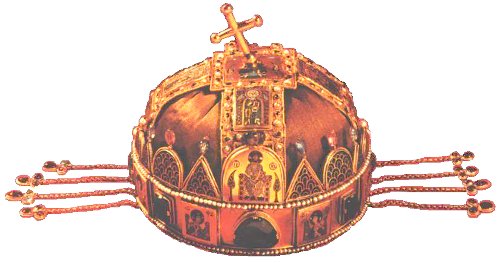
The Holy Crown of Hungary
First the group of engineers and the group of goldsmiths, independently of each other, came to the conclusion that there is no difference between the top cross section and the bottom band as far as workmanship, material or any other aspect. The whole crown was made in one workshop at the same time.
The second astonishing discovery was based on the comparison made of the workmanship and material found in other jewelry and similar objects of the time. The crown had to have been fashioned around the late 300's or the early 400's A.D. in the area east of the Black Sea and south of the Caucasus Mountain divide (today's Georgia). Unfortunately, it is difficult to determine for whom the crown was made, or how it arrived in Hungary to begin with. Some suggest it may have been made for a Hun king, among others. After the demise of the Hun Empire, it wound up in the hands of the advancing Avars from the East as they conquered the Carpathian Basin around 560 A.D. Charlemagne subsequently conquered the Avars of western Hungary in 795-96 and some believe that the crown fell into his hands at some point. According to legend, Pope Leo III crowned Charlemagne on Christmas day in the year 800 with this very same crown. The Emperor ordered his subjects to bury him with it and this came to pass in 814.
In the year 1000 A.D., upon the insistence of Pope Sylvester II, the German Emperor Otto III issued an order to open Charlemagne's tomb and recover the crown. The Pope promised it to the Polish king Boleslo. The Hungarians must have known something about this crown, probably demanding that it be returned to them. So, Pope Sylvester in his dream received a message from God to give this Holy Crown to the Hungarian King for his services to the Catholic Church and for his good deeds to God. Hungary was a powerful country at this time and if the Hungarian king declared that the crown belonged to him then it was his crown. On Christmas day in 1000 A.D., Saint István (Stephen) was crowned with the same crown that Charlemagne had been crowned with two hundred years earlier.
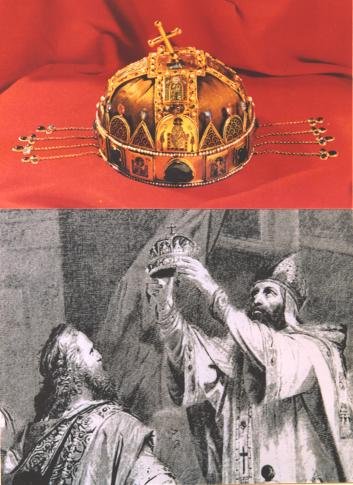
The coronation of Charlemagne by F. Kaulbach: Notice the striking resemblance of the crown in the pope’s hands and the Hungarian crown.
However farfetched and unbelievable this account may be, it was in fact a German Canon who initially led a Hungarian priest, István Szigeti, in the direction of this story. Ordered by the Bavarian governor, Maximilian II in 1850, a painting by Fredrich Kaulbach of the coronation of Charlemagne shows the crown in the Pope's hands, a crown with an uncanny resemblance to the Hungarian Holy Crown. Could it be mere coincidence? Or did influential people in the West know something about it and perhaps still do? What a riddle!
The history of the idealized concept of this Crown is no less amazing or singular than the material one. Originally there were 4 martyred saints, 4 archangels, 8 apostles, God, Jesus and the Virgin Mary (altogether 19 enamel pictures) found on the crown; four of the original ones are now missing: two archangels, Apostle Bartholomew and the Virgin Mary.
God's picture is on the top, under the tilted cross; on the front is the image of Jesus, and across from it on the back was a picture of the Virgin Mary. At the top of Mary's frame was a tulip, which represented the Holy Spirit. Isabelle, the wife of King Szapolyai broke off this tulip, when she turned the Crown over to King Ferdinand in 1541. With the pictures positioned in this manner, Christianity's basic doctrine (the Holy Trinity) manifests itself in the display. On Jesus' side are the military saints (Demeter and George) and the archangels, like Michael, carrying out the judgment of God. At Mary's side are the medical saints (Kozma and Damian) and the archangels, like Gabriel, bringing good news. The Apostles are: Peter, Andrew, John, Jacob, Thomas, Paul and Philip. Interestingly enough there are some ancient, so called "pagan" symbols (like the sun and the moon) that can also be found on the crown.
Gábor Pap, a Hungarian researcher, believes that the construction of the Holy Crown was designed on the religious teachings of the Persian prophet Manes. However, the origin of this philosophy could be traced back to the Scythians, according to Pap; this would also explain the so-called pagan symbols on the Holy Crown.
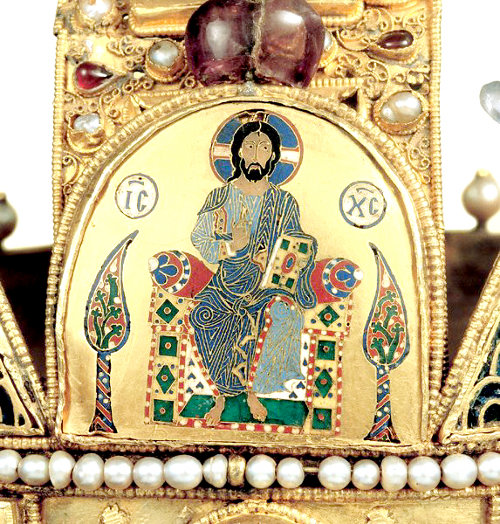

Picture of Jesus on the Hungarian Crown and hand detail.
(See Editor's note)
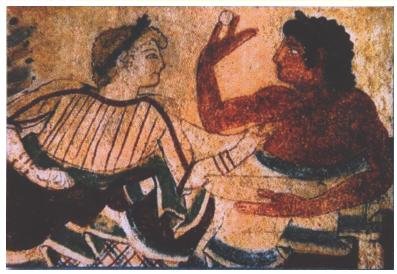
The parallel of the Etruscan wall painting and the picture of Jesus on the Hungarian Crown.
Recently Zsolt Mesterházy, another Hungarian researcher, recognized a parallel between an Etruscan wall painting and Jesus' picture on the Holy Crown. On the Etruscan painting, there is a male (god) figure holding an object between his thumb and his ring finger, seemingly offering it to the female (goddess) figure in front of him. The object itself could be a ring, a pearl, or a seed of some sort. The meaning of it, in all likelihood has some connection to the ancient fertility culture, which was a guiding force of the social order in early civilizations. A pearl can be seen between the same fingers of Jesus on the Hungarian Crown. This probably symbolizes eternal life. The Eastern Orthodox Church has many icons with a similar hand and finger position, but none of them has a pearl or some sort of object between the fingers. So it seems this may be additional proof that the Hungarian Holy Crown was made at the very same time and place that Christianity and the ancient cultures first made contact with one another.
There are only assumptions regarding just exactly when and why the Hungarian Crown became known as Holy, or in Hungarian: Szent. Even more intriguing is the question of when and why it was personified; when did it begin possessing the power to ‘rule’ like a living person? One must understand that in the Hungarian Kingdom everything belonged to the Holy Crown, which possessed all the powers of the land; the king merely enforced the Crown's laws. This was a highly idealistic form of governing. In one of his letters dated from the middle of the thirteenth century, King Béla IV (1235-1270) spoke of the Crown being Holy; he separated the king's power from the Crown's. Some suggest that this crown was made for Jesus, to crown him at the time of His resurrection as King of the World. That would account for the source of its holiness. It is incredibly intriguing that such a thought could crop up in anyone's mind. But, that's just part of its allure: the numerous unsolved mysteries surrounding the Hungarian Holy Crown.
Originally, only the nobility by birth enjoyed the protection of the Crown. Later those who acquired titles for service of the country were also included. However, in 1848 all citizens of the Holy Crown were entitled to the same protections, and charged with the same responsibilities.
Hungarians recognized their kings as rightful rulers only when they were crowned with the Holy Crown. This may be one reason for it having been stolen, buried and lost numerous times throughout the centuries; however miraculously – somehow – it has always been found again and again.